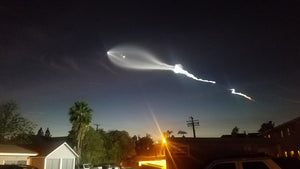February- Eclipse Ready? Castor and Aristotles's Cluster
Aristotle's Cluster- M41
Messier 41, also known as Aristotle’s Cluster, is a treat for sky gazers. Under dark skies, it's visible to the naked eye, but in suburban locations it a prime target for both binoculars and telescopes. Positioned just four degrees south of Sirius, a bright star, it conveniently fits into the same binocular field of view.
Through 10x50 binoculars, the cluster reveals a distinct shape, showcasing a circular void on its western edge. A small telescope enhances the experience, unveiling a loose cluster comprising around 50 individual stars. The central point boasts an orange star as the brightest, accompanied by a fainter yellow companion. Groups of stars are scattered throughout the cluster, adding to the spectacle.
Alpha Geminorum- Castor
Castor, the second-brightest star in the Gemini constellation, might appear as a single point of light in the night sky, but it's actually a bustling system of six stars grouped into three binary systems. Situated about 51 light-years away, Castor earns its place among the top 23 brightest stars, as noted by The Royal Astronomical Society of Canada.
Despite being the second-brightest in Gemini with a magnitude of 1.58, Castor goes by the name Alpha Geminorum. This nomenclature might seem unusual since the "alpha" designation typically goes to the brightest star in a constellation. In Gemini's case, that honor belongs to Pollux (Beta Geminorum), which forms the head of Castor's twin brother.
When viewed through a quality telescope, Castor unveils its hidden complexity as a sextuplet of stars, adding an extra layer of intrigue to its observation.
Are you Eclipse Ready?
With the Great American Solar Eclipse only 2 months away, the time to prepare is NOW! In 2017, a total solar eclipse captivated the "Lower 48" for the first time since 1979 and spanned the U.S. coast to coast. Surprisingly, another total solar eclipse is set to thrill North America on April 8, 2024. This will be the last eclipse visible in the United States until 2045.
This time, the Moon's expansive shadow, about 115 miles wide, will traverse Mexico, sweep northeast from Texas to Maine, and cast darkness over parts of Eastern Canada for a time period of up to 4 minutes and 27 seconds. That's almost twice the length of 2017.
During a total solar eclipse, the Moon briefly obscures the Sun's bright photosphere, unveiling the outer atmosphere—the ethereal corona. Composed of rarefied gas heated to millions of degrees, the corona, stripped of electrons, dances in streamers and loops sculpted by the Sun's magnetic field. This hauntingly beautiful display stands as one of nature's most awe-inspiring sights.
Positioning yourself within the path of totality is essential for the ultimate experience! While most of North America will witness a partial solar eclipse, the spectacle pales in comparison to the total eclipse. The path, stretching from Mexico to Canada, offers varied locations, but choosing spots with favorable weather conditions, such as Mexico or southern Texas, is recommended. If travel constraints arise, securing a spot within the path, wherever possible, guarantees a celestial event that won't disappoint.
Be sure to check our huge line of solar observation equipment. Whether it's specially designed glasses, solar filters, or solar telescopes; investing in proper equipment ensures a safe and unforgettable encounter.
Get Solar Equipment Here!







